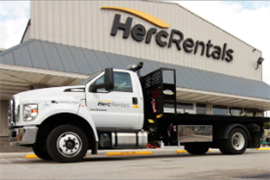Heavy dues
01 May 2008
To paraphrase a popular axiom, it's a manufacturer's world. This may not seem the case when reports of factories closing continue to make the headlines, or when the proportion of GDP generated by the manufacturing sector continues to fall.
But in the world of heavy machinery rental across Europe, those involved are predominantly, though not exclusively, manufacturers or their dealers. Most major manufacturers across most European markets have more or less developed rental businesses.
“Certainly the [heavy equipment rental] market is dominated by the manufacturers’rental parks,”said Hubertus Marx, managing director of Liebherr Mietpartner, the German producer's rental arm.
Benoit Fosseprez, the man in charge of developing the European rental market for Komatsu, agreed: “The heavy range of rental machinery is more a business for manufacturers than for pure hirers.”
However, as with so many other things in this diverse continent, the extent of manufacturer involvement, whether direct or through dealers, differs considerably from country to country.
“There are big geographical variations across the market,”said Mr Fosseprez: “In France and the UK, for example, our focus is to sell machines to rental companies as these markets have good rental partners. In Italy the market for rental is just being developed. In Germany it's mixed-we sell to some rental companies and also work with our dealers.”
This analysis is shared by Mr Marx: “The distribution of our rental fleet across Europe is not even and depends heavily on the traditions of the construction industries in the various countries.”
In the developing Italian market, for example, manufacturers have been keen to get involved. “Many new rental initiatives have come from manufactures or through their dealers,” said Alessandro Pezzali, rental marketing manager for Italian Caterpillar dealer CGT.
In Portugal, two major players, both manufacturers, dominate the market. “The main companies are Volvo Rents and Cat Rental,” said Jorge Patricio, managing director of Volvo Rents in Portugal: “Both fleets have around 100 machines and are completely linked with the Volvo and Cat brands for heavy machinery.”
Even in France, where the independent rental market is more highly developed than in many other countries, manufacturers play a major role. “If you look at the rental market for heavy machinery, without operators, there are maybe five or six companies known throughout France,” said Bernard Fournier, the head of Loxam TP, Loxam's heavy equipment rental division. “This ranges from manufacturers such as Caterpillar, Liebherr and Komatsu, who do rental through their dealers, to pure rental companies like us.”
Complex Machines
One reason for the heavy involvement of manufacturers in rental markets, according to the manufacturers at least, is the relatively onerous task of providing service and back up for such big, complex machines.
“We've got greater service capacity and know-how with the machines,” asserted Mr Fosseprez. “We can offer more service relative to independent rental companies.”
Not that this cuts much ice with Loxam's Mr Fournier, who pointed out that it is the manufacturers who provide the servicing for Loxam. “We have specific contracts with manufacturers so that they offer full service for our customers. They undertake to service or repair machines wherever they are across the country.”
Perhaps a more compelling reason for the number of manufacturers involved in heavy equipment rental is the significant costs required to be a part of it. Put simply, the machines that you need are large and expensive.
Liebherr Mietpartner, for example, runs a fleet of nearly 1000 rental machines. “To erect rental parks of such magnitude is only possible if you've got the capacity for substantial investment,” pointed out Mr Marx. “This limits the options for pure rental businesses, who also face constraints on their ability to cover large areas without breaks in the service they can offer. ”
Not that you need the vast number of depots and outlets that you do for compact equipment to provide far-reaching or national coverage for heavy equipment rental.
Even with the huge variety of machinery CGT offers (“The rental fleet consists of over 1000 new construction and paving machines, not just for earth-moving but also lifting - mobile cranes and telehandlers - demolition, recycling and energy...” said Mr Pezzali) and the fact it is also a dealer, the company only has 25 outlets across northern-central Italy.
In France, three years after its foundation, Loxam TP, still has just one branch to serve the whole country. This is compared to the nearly 200 branches the company has for its compact rental range.
According to Mr Fournier, this is because the rental arrangements for heavy machinery differ considerably from those for smaller kit. “The duration of hire contracts for heavy machinery in general is longer than those for compact kit,” he explains, even if there is considerable variation within the rental of heavy equipment across different products.
“Compactors, for example, go out for long periods, whereas it's much shorter for excavators,” he said. “This is because they go to different customers. The main contractors on very big jobs, like road and rail projects, will use compactors for anything from six months to two years; we've got 22 on the same TGV site at the moment, for example. Excavators go to the smaller sub-contractors for part of each project, so their average hire might only be one to two weeks, maybe a month. Wheel loaders would be somewhere in between, maybe a couple of months on average.”
With fewer machines going out for longer periods, the need for geographical proximity to customers is reduced. Nevertheless, Mr Fournier said the company wants to expand its coverage, although not greatly. “We're confident it is a growing market, and over the next three years we will open more branches to cover the rest of the country, probably four to five.”
Even accounting for the differences in rental arrangements between heavy and compact equipment, a mere four or five branches to cover a country the size of France indicates the lack of penetration when it comes to renting heavy kit.
Market Size?
Such an analysis is echoed on a European scale. “How big is the market for the rental of heavy machines?”asked Mr Fosseprez: “Judging by our sales to rental customers, maybe 20% of the total market for construction equipment above 13 to 15 tonne.” This compares to the near 80 to 90% of some compact machinery in highly developed rental markets like the UK.
Not that it is easy to ascertain an exact figure. “It is difficult to give precise estimates on the rental market for large machinery in Europe since no statistics are available,”said Mr Marx. “Talking about machines in excess of 20 tonnes, I would assume that the total European rental fleet approximates to some 3000 to 3500 machines. ”
In France, according to Loxam TP's Mr Fournier, the reasons for this smaller market are twofold. “First, the demand for the use of these heavy machines is considerably less in terms of numbers than it is for light equipment; second, there is still a trend among the larger companies that own this type of kit to want to buy it. ”
“The French mentality is still a bit like the German one,” he added. “Companies think it's better to own kit, and they like to be able to show they can afford to buy it. To develop the rental market we need to change this mentality. We need to change the investment strategy of companies. ”
If this seems like a tall order, Mr Fournier insisted this has already happened in compact equipment. “We succeeded in doing this when it comes to smaller kit by increasing the range of products on offer, so we can meet all their needs. Companies are now confident the availability is there and they can find the right machines on a daily basis. We're not there yet with the heavy range. We've started, with compactors, and the business with excavators is growing as we have more on offer-12, 15, 25 tonne machines... The more we develop the range of products on offer, the more the market will grow.”
This desire to offer a wide range of equipment to entice would-be customers is apparent in Germany as well. “We rent across our whole range of equipment, from utility kit up to the heavy range, as well as complementary products including compaction and compression,”said Mr Fosseprez.
On a European level this approach appears to be working, with a growing number of companies coming round to rental.
“In the last two years the Italian rental market has grown +15 to +20% per year,”said Mr Pezzali. “Everywhere we look there are a lot of new rental initiatives, and this growth is set to continue.”
Perverse as it may seem, this apparent success comes against a backdrop of wider economic uncertainty. “The poor economic climate in Germany and a market growing unevenly by project means rental is growing in popularity,”said Mr Fosseprez.
A similar situation exists in Portugal. “For our customers there are some great advantages in short term rental at the moment,”explained Volvo Rents’Jorge Patricio. “First of all, our economy is in bad shape. Some of our mid-size customers have reasonable fleets but public investment in big projects has decreased in the past few years. When these customers now win some short-term work they think twice before buying new equipment, because they don't know if they will have more work to do. It's become an important reason to rent heavy machinery.”
In such a context, according to Mr Pezzali, renting machinery has clear advantages. “The customer isn't bound by a large investment; he can reduce his fixed costs in favour of a variable cost; he can increase business flexibility; and he knows what the cost will be in advance.”A compelling case for more rental, it would seem.






